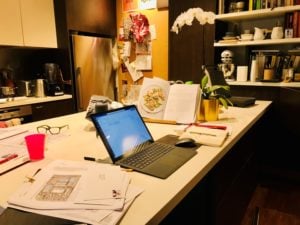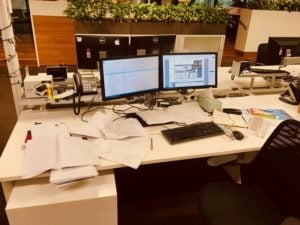As the world narrows, Sue Wittenoom is learning to share her work-from-home spaces and have a clean desk before dinner.

I’ve been telling people that you don’t need to go to work for the past 25 years. For half of that time I haven’t actually had a desk anywhere either. I’ve been an independent advisor since 2015 and my work gets done all over Sydney. Before the lockdown my options would range across home, a co-working hub, client sites, libraries, coffee shops and hotels.
Since the end of March that world has narrowed to home, with the occasional dash into AECOM’s George Street offices to get a report out. Wherever I find myself – and the pictures here are me at work on the kitchen bench (above) and me at an AECOM hotdesk (below) – it’s always a clean desk at the end of the day. My Hub Hyde Park flex membership of eight days of co-working per month has been cancelled. And my home ‘office’ – a three-bed Redfern apartment – has been overrun by two twenty-something daughters and my architect husband who sits in back-to-back zooms all day.

When I have home to myself I move between the kitchen bench, the dining table and a leafy courtyard. Now the four of us juggle across these spots. Luckily the girls both have good set-ups in their bedrooms, which have seen them through the HSC and Uni years. But everyone-at-home-all-the-time is, to use the word of the day, unprecedented. We would talk about organisational resilience when we were making the business case for workplace flexibility, but we never imagined a pandemic lockdown that looked like this.
Working from home used to mean something else entirely. It used to be a respite from the office and everything involved in getting there. When we were helping corporate clients make the shift to more flexible workplaces, we would often test the appetite for more distributed working by asking this question before we made the transition to flexible work inside the office:
“Ideally, and thinking about the work you do, how many days a week would you like to work from home?”
Only 10% said never. Even fewer said all the time. Around 40–50% wanted 1–2 days/week, and 30–40% a couple of days/month. The idea of having more autonomy, more control over your schedule, and spending some of your time away from the office had broad appeal across many different sectors.
As part of one post-occupancy review, we ran another survey after the flex work program was implemented. These people now shared a range of different work settings in an office, with each team agreeing their own rituals and ways of staying connected across the week and in different locations. Even with new focus spaces and rooms for google hangouts, the new space was buzzier and more interactive (remember that the alternative is dead and boring). How were they travelling? Here is a sample of their feedback:
“I find that often time out of the office is more productive as there are less distractions.”
“Job satisfaction is vastly improved. Travel times are extreme and at least this way I have some of my life back under control.”
“I can complete focused work in less amount of time and with better quality.”
“Less interruptions at home, therefore I am more productive. I save the work where I have to really concentrate to this day, which helps me plan the rest of my week.”
Time together is better when you can have some time apart. When the lockdown restrictions are lifted, we’ll gradually get back to working together. But let’s not swing back to insisting that everyone shows up at the office at the same time, all the time.
Sue Wittenoom is the Founder of The Soft Build, a consultancy that helps clients use design for change. As Director of DEGW and AECOM’s Strategy+ practice, she helped many different organisations think differently about working from home some of the time.




















